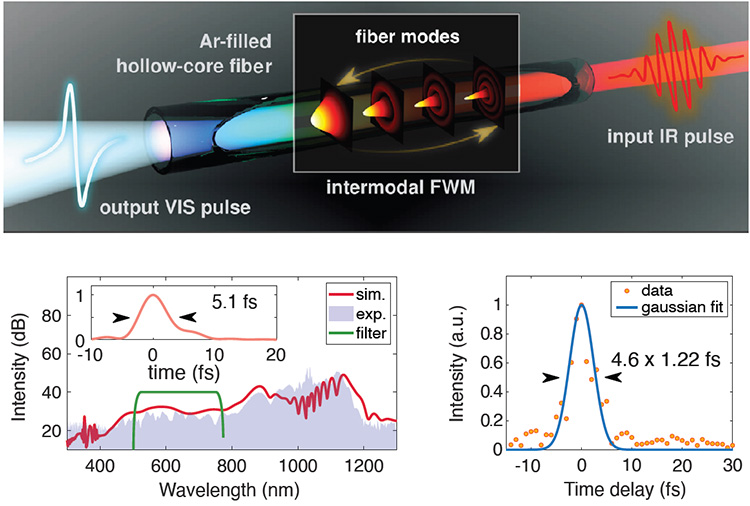 Top: Sketch of the system and concept. Bottom left: Simulated and experimental output spectra. Inset shows numerically calculated visible pulse corresponding to filtered (green line) portion of spectrum. Bottom right: Experimental autocorrelation trace of the visible pulse performed via transient-grating FROG. [Adapted from R. Piccoli et al., Nat. Photon. 15, 884 (2021)]
Top: Sketch of the system and concept. Bottom left: Simulated and experimental output spectra. Inset shows numerically calculated visible pulse corresponding to filtered (green line) portion of spectrum. Bottom right: Experimental autocorrelation trace of the visible pulse performed via transient-grating FROG. [Adapted from R. Piccoli et al., Nat. Photon. 15, 884 (2021)]
The visible portion of the electromagnetic spectrum—commonly just known as “light”—has been the target of human investigations for millennia. Directly related as it is to the perception of reality, it promptly drew the attention of Greek philosophers such as Pythagoras, who believed that light emanated from our eyes to illuminate objects and thus return information of our surroundings. Visible light is at the foundation of our own existence and daily experience, being essential for photosynthesis1 and human vision.2 It also is of paramount importance in modern optoelectronic technologies through the formation of excitons (excited electron-hole pairs) in semiconductors.
Despite this central role, the generation of ultrashort and intense pulses of visible light capable of temporally resolving such fundamental processes has been a great challenge since the very invention of the laser. Indeed, the lack of suitable laser media in the visible domain has required alternative strategies to convert near-infrared radiation—emitted by well-established laser technologies based on Ti:sapphire or ytterbium media—into visible light. The most common one relies on the use of optical parametric amplifiers,3 in which various nonlinear phenomena act in the time (or, equivalently, frequency) domain to alter the frequency content of the driving laser and reach the visible spectral band.
Such technologies however, are typically complex, expensive and bulky. To overcome these difficulties, we have developed a new paradigm that exploits nonlinear phenomena also in the spatial domain.4
Specifically, we employed a large-core, argon-filled hollow-core fiber supporting many spatial modes (the natural shapes that light takes while propagating in the fiber). We found that, under specific conditions of gas pressure and propagation length, a long pulse of around 200 fs, emitted by a common ytterbium laser and launched into the fiber, is directly converted, at the output, into an extremely short visible pulse of roughly 5 fs—just about two cycles of electric-field oscillation—with microjoule energy. We showed that this phenomenon is due to the nonlinear transfer of energy between the fundamental spatial mode and higher-order modes that, along the propagation direction, induces a rapid expansion of the laser spectrum toward the visible.
Our findings represent a new route and a significant simplification in the generation of intense few-cycle visible light. They can thus lead, we believe, to a wealth of applications in biology, ultrafast science, condensed-matter physics and nonlinear optics generally.
Researchers
Riccardo Piccoli, Young-Gyun Jeong, Andrea Rovere, Luca Zanotto, François Légaré, Roberto Morandotti and Luca Razzari, INRS-EMT, Varennes, QC, Canada
Jeffrey M. Brown and Arnaud Couairon, CNRS, Ecole Polytechnique, Institut Polytechnique de Paris, Palaiseau, France
Mette B. Gaarde, Louisiana State University, Baton Rouge, LA, USA
John C. Travers, Heriot-Watt University, Edinburgh, UK
Bruno E. Schmidt, few-cycle Inc., Varennes, QC, Canada
References
1. G. Cerullo et al. Science 298, 2395 (2002).
2. R.W. Schoenlein et al. Science 254, 412 (1991).
3. G. Cerullo et al. Opt. Lett. 23, 1283 (1998).
4. R. Piccoli et al. Nat. Photon. 15, 884 (2021).
